Photosensitive Epilepsy and COVID-19
Background
Photosensitive epilepsy is a type of epilepsy in which seizures are triggered by exposure to flashing lights at certain intensities or certain visual patterns. TV and computer screens, video games, strobe lights, flickering florescent lights, and natural light are common triggers for individuals with photosensitive epilepsy (Wirrell & Hernandez, 2019). As many aspects of normal life have moved online throughout the COVID-19 pandemic, a serious concern for individuals with photosensitive epilepsy is how increased TV and computer screen time may impact their seizure activity. Listed below are some general recommendations to prevent light-triggered seizures and maintain health and safety for people with epilepsy throughout the COVID-19 pandemic.
Recommendations
General recommendations for individuals with photosensitive epilepsy include: avoid exposure to strong environmental lights (i.e., flashing lights, flickering florescent bulbs, cathode ray tube television, and patterns from Venetian blinds). Recommendations for watching television include: sit at least five feet away from the screen in a well-lit room, reduce screen brightness, avoid watching for long periods of time, and wear polarized sunglasses while viewing to reduce glare. Recommendations for playing video games include: sit at least two feet away from the screen in a well-lit room, reduce screen brightness, take frequent breaks, and avoid playing when tired. Covering one eye (monocular vision) is the most useful strategy to prevent a photosensitive reaction (Wirrell & Hernandez, 2019; Erba, 2006).
In the context of COVID-19, adhering to and maintaining routines is of the upmost importance. For example, leveraging pillboxes, alarms, or phone apps to track medication adherence may be helpful if the individual with epilepsy is separated from their usual caregiver. In addition, maintaining a regular medication supply (i.e., 3-months) to prevent medication shortages is crucial. Generally, ensuring adequate sleep, engaging in routine exercise, healthy eating, avoiding alcohol and recreational drugs where possible, and following other specific instructions of the treating physician to avoid breakthrough seizures should be prioritized. Specific to individuals with stimulus-induced reflex epilepsies (i.e., photosensitive epilepsy), reducing or eliminating provocative stimuli such as computer games or prolonged exposure to computer/TV screens may be necessary. Social isolation associated with COVID-19 may exacerbate existing mental health issues, which are already common among people with epilepsy, and taking appropriate steps to treat mental health comorbidities is important (French et al., 2020).
Conclusion
Photosensitive epilepsy is a type of stimulus-induced reflex epilepsy that affects 3-5% of the 2.7 million Americans living with epilepsy and can be diagnosed with relative ease via EEG (Erba, 2006). Various preventative strategies exist to avoid stimulus-induced seizures and should be tailored to the specific needs of the individual at the recommendation of the treating physician.
Author: Colette Cambey
AmeriCorps Member, NH Community Health Corps
Epilepsy Foundation New England
References
Harding, G., Wilkins, A. J., Erba, G., Barkley, G. L., & Fisher, R. S.
(2005). Photic‐and pattern induced seizures: expert consensus of the Epilepsy Foundation of America Working Group. Epilepsia, 46(9), 1423-1425.
French, J. A., Brodie, M. J., Caraballo, R., Devinsky, O., Ding, D., Jehi, L., ... & Cross, J. H.
(2020). Keeping people with epilepsy safe during the Covid-19 pandemic. Neurology, 94(23), 1032-1037.
Wirrell, E. & Hernandez, A.
(2019) Photosensitivity and seizures. Epilepsy Foundation.
https://www.epilepsy.com/learn/triggers-seizures/photosensitivity-and-seizures
Erba, G.
(2006). Shedding Light on Photosensitivity, One of Epilepsy's Most Complex Conditions. Epilepsy Foundation.
https://www.epilepsy.com/article/2014/3/shedding-light-photosensitivity-one-epilepsys-most-complex-conditions-0
